|
Humidors
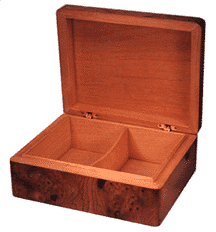 A humidor is simply a well made box designed exclusively for the purpose of storing cigars. Many of the better ones have lift out trays and dividers which are of great benefit. These features help you organize your cigars and allow easy access to the cigars you might wish to smoke at any given time. A humidor is simply a well made box designed exclusively for the purpose of storing cigars. Many of the better ones have lift out trays and dividers which are of great benefit. These features help you organize your cigars and allow easy access to the cigars you might wish to smoke at any given time.
They come in a wide variety of sizes, shapes, and colors. Some are simple classic designs while others are wildly exotic. Humidors can be quite expensive so you should view a wide variety and take your time when selecting one. A good humidor should not only serve your needs, but your sense of beauty as well.
Pre-Purchase Humidor Tips:
There are some very serviceable humidors on the market for inexpensive. However, you need to be extra critical when purchasing one and you should not expect most of them to be as stable or well made as those priced higher. If you live in an area where the ambient climate is close to an ideal cigar RH then this probably won't be as important. However, if you live in place where the ambient humidity drops below 45% RH then you need to be more concerned. A good humidor will not only protect your cigars, but will quickly become a cheirshed piece of heirloom furniture. If you are interested in economical cigar storage you will most likely be better served by maintaining your cigars in a plastic container.
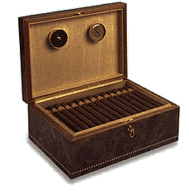 When selecting a humidor it is best to select one with 5/8" or greater wall thickness. This thickness provides a good buffer between the outside ambient climate and your prized cigars. When selecting a humidor it is best to select one with 5/8" or greater wall thickness. This thickness provides a good buffer between the outside ambient climate and your prized cigars.
There are many exceptional wood choices, but the standard is mahogany. You will never go wrong selecting a high quality mahogany box.
Spanish cedar liner is a big plus. It serves three functions:
First it acts as an additional buffering agent since the wood is absorbent and regulates at 60%-70% along with your cigars.
Secondly, it helps to discourage beetle infestations from moving around from cigar to cigar. Beetles and other pests dislike the bitter flavor of Spanish Cedar.
And finally, it imparts a slightly spicy flavor to your cigars as they age. This taste is appreciated by most smokers.
If you do not like this flavor note do not hesitate to not have a Spanish Cedar lining - it is not essential. However, western cedar, red cedar, and/or aromatic cedar are NOT suitable substitutes for Spanish cedar. These woods will ruin the flavor of your cigars.
Look for a humidor with quality workmanship throughout. Tight seal, good corner joints, perfect hinge installation. etc. A good humidor will be heavy and solid, and this is essential to prevent warping in the future. Remember a humidor endures a tremendous amount of stress. For example in the winter where I live the heat runs constantly resulting in an indoor ambient humidity of roughly 30%, yet my humidors maintain a constant near 67% on the inside. This type of immense relative humidity delta puts a tremendous strain on the wood and the joints of any humidor.
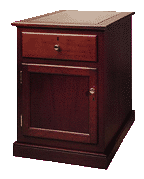 Lift out trays and movable dividers are a big plus when selecting a humidor, particularly if made of Spanish cedar. Lift out trays and movable dividers are a big plus when selecting a humidor, particularly if made of Spanish cedar.
Make certain that there is room in the lid for the humidifying device you will utilize. You don't want to have wasted space because your Credo hangs too low in your humidor.
Make certain that all exterior sides of the humidor are sealed, including the bottom.
Remember that claims of being a 25/50/75/100/200+ capacity humidor are typically based on corona/corona extra sized cigars. If you primarily smoke large cigars it is important to adjust these numbers as appropriate. Also if you are buying the humidor via mail order ask for the inside dimensions so you can confirm that it has the storage volume you desire.
Only purchase a humidor from a retailer and/or manufacturer that is willing to stand behind their product 100%. Ensure that they will refund your money upon demand, if they won't - Buy Elsewhere!
Breaking in your New Humidor:
First step in breaking in a new humidor is to be absolutely certain that your hygrometer is accurate. To do so, perform the Salt Calibration Test included in the Hygrometer section below .
A brand new humidor requires time to come up to the appropriate humidity. Depending on your climate and how dry the wood is this can take as little as a few days to upwards of a few weeks.
You can speed up this break-in period by wiping the insides down with a towel moistened with distilled water. BUT be very careful to not over do it, because if you do you will cause an ugly water stain on the inside of your pristine humidor. Personally, I DO NOT recommend you do this; it is much better to just be patient and allow your humidor to come up to humidity on its own.
It is not necessary to initially charge a Credo with propylene glycol. It comes from the manufacturer already pre-charged, as do most humidifiers. If in doubt, you should ask the tobacconist or manufacturer. If they don't know then go ahead and rinse the humidifier completely, allow to dry, and then begin with a 50/50 charge of PG and distilled water.
After your humidor reaches 63% or so it is a good idea to introduce cigars to it. A humidor will stabilize better and more evenly when 75%+ of its volume is full. Try to maintain this volume of cigars at all times if possible. Open air space inside a humidor is your enemy. By the way, this is an excellent and legitimate explanation to give your spouse as to why you MUST buy another two boxes of your favorites cigars.
Maintaining your Humidor:
 Add distilled water to your humidifier when the relative humidity begins to dip. After the humidor has been stabilized this dip should occur slow and steady... 69%, 68%, 67% and so on. Typically I add distilled water when I hit 64% or so. Remember to NOT saturate the Credo, but to only moisten it! This is the biggest error most new humidor owners make, keep in mind that a Credo not only raises the humidity to 70% RH, but it also lowers the humidity when it exceeds this level. Therefore it is essential that there be room left within the Credo's volume to absorb the excess moisture if necessary. Add distilled water to your humidifier when the relative humidity begins to dip. After the humidor has been stabilized this dip should occur slow and steady... 69%, 68%, 67% and so on. Typically I add distilled water when I hit 64% or so. Remember to NOT saturate the Credo, but to only moisten it! This is the biggest error most new humidor owners make, keep in mind that a Credo not only raises the humidity to 70% RH, but it also lowers the humidity when it exceeds this level. Therefore it is essential that there be room left within the Credo's volume to absorb the excess moisture if necessary.
Only use distilled water. Tap water has chemicals and minerals that you do not want in contact with your cigars as they age. Also tap water contains organics and is prone to developing mold. Distilled water is the only readily available water that is free of both mineral and organic impurities.
Do not be anal retentive about the RH humidity. Any number between 64% and 72% is fine, truth is every cigar smokes different. Some will be best at 68%, while other less tightly rolled cigars will burn better at 72%. Some people like their cigars even drier and try to keep them closer to 60%. Ignore what everyone tells you about 70/70 and experiment with slightly drier and wetter humidities until you find what you like best. Personally, I prefer 65%-67% RH as the ideal relative humidity.
Temperature control is not nearly as critical as the humidity. Any temperature between 50-75 degrees is fine. A couple of notes though, at the lower temp the aging process slows down, while at the higher temp the hatching of the dreaded tobacco beetle is a potential risk. More importantly always keep your humidor out of the sunlight - being bathed in the sun's rays drastically escalates the internal temperature within the box. Also never place it on a television set or near a stereo system, as any such electronic device will generate considerable heat.
Totally DISREGARD any table or advice explaining that the ideal humidity for storing your cigars changes depending on the temperature. This is a myth that sadly has been published in some otherwise respectable publications. It is based on the principles of absolute moisture content and not relative humidity. 70% relative humidity is 70% relative humidity regardless of the temperature hence the term "relative."
Humidifiers:
Humidifiers are what maintain the desired relative humidity within your humidor.
There are two primary types of humidifiers: Active and Passive.
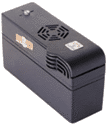 Active humidifiers are electrically powered and typically utilize a built in electronic sensor to determine whether they should add moisture to the air. A few very top end units will also extract extra moisture content from the air, but most do not. Typically these units are very expensive and are intended for use with large furniture size humidor cabinets, however there are a few on the market for smaller humidors. One distinct advantage of active humidifiers is that you can typically set them to maintain a lower relative humidity easily if you so desire. Active humidifiers are electrically powered and typically utilize a built in electronic sensor to determine whether they should add moisture to the air. A few very top end units will also extract extra moisture content from the air, but most do not. Typically these units are very expensive and are intended for use with large furniture size humidor cabinets, however there are a few on the market for smaller humidors. One distinct advantage of active humidifiers is that you can typically set them to maintain a lower relative humidity easily if you so desire.
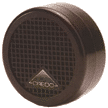 Passive humidifiers do not rely on any power whatsoever, are of simple design, and utilize basic vapor conduction to regulate relative humidity. These devices are typically inexpensive and serve almost everyone's humidifier needs. Although not as sophisticated as active humidifiers, passive ones very capable of providing a stable environment for your cigars. Not only are they utilized in desktop humidors, but also in large cabinet furniture-size ones as well. Passive humidifiers do not rely on any power whatsoever, are of simple design, and utilize basic vapor conduction to regulate relative humidity. These devices are typically inexpensive and serve almost everyone's humidifier needs. Although not as sophisticated as active humidifiers, passive ones very capable of providing a stable environment for your cigars. Not only are they utilized in desktop humidors, but also in large cabinet furniture-size ones as well.
Commonly passive humidifiers are referred to as "Credos" regardless of their actual brand. This is because the Credo Company manufactures the unit that is regarded as the benchmark for passive humidifiers.

Passive humidifiers have traditionally been constructed of sponge, clay, or oasis florist foam encased in a perforated container. The foam is moistened with distilled water and then placed within the humidor. Of the three different materials clay is the most durable while the oasis foam is the best for regulating because of its open cell structure that allows for it to retain large quantities of water. Any of the three are functional, but personally I recommend you opt for units utilizing the green oasis florist foam.
Passive humidifiers control the relative humidity within your humidor by hydroscopic interaction with the air's moisture content. In lay terms, it basically expels moisture from the humidifier when the ambient relative humidity is below 70% and absorbs water when the ambient relative humidity is above 70% RH. It accomplishes this task via the chemical Propylene Glycol which acts as the hydroscopic agent. Most passive humidifiers are charge with a 50/50 solution of PG and distilled water.
 Propylene Glycol (PG) is an inert chemical that is used in a wide range of products including animal feed, hair care products, medicines, etc. It is safe to handle and consume if you so desire. It can be bought at most cigar stores but typically it is labeled as "Regulating Solution" and is sold for upwards of $20 for two ounces. I suggest you buy it from your local pharmacy instead when it usually can be bought from the pharmacist's counter for about $7 a pint. Propylene Glycol (PG) is an inert chemical that is used in a wide range of products including animal feed, hair care products, medicines, etc. It is safe to handle and consume if you so desire. It can be bought at most cigar stores but typically it is labeled as "Regulating Solution" and is sold for upwards of $20 for two ounces. I suggest you buy it from your local pharmacy instead when it usually can be bought from the pharmacist's counter for about $7 a pint.
When the humidity dips below 70% RH in your humidor the PG expels the water contained in the humidifer, but when the relative humidity is over 70% it absorbs water. This is why it is critical to never overfill your humidifier as it needs to have room left in order for it to absorb moisture if need. Over time the PG will expend all of the water contained within the humidifier assuming you live in area with a lower than 70% RH and it will require you to add more distilled water. You do not have to add more PG though, as it will remain in the humidifier until you rinse it out. In addition to it regulatory properties, PG also serves as an anti-bacterial agent which will help to prevent molding.
Almost all commercially available humidifiers come pre-charged with PG so there is no need to add any in the beginning. If in doubt, you can rinse it thoroughly allow it to dry, and recharge with the 50/50 solution. Over time your PG will slowly evaporate from the humidifier, so I recommend you rinse clean and recharge your humidifier with 50/50 once ever year or two.
Over recent years an alternative to PG regulated foam-style passive humidifiers has been introduced to the cigar smoking public. These newer units utilize a silica gel bounded with a salt derivative to maintain the relative humidity of 70% RH. These Salt-treated silicon dioxide beads work on the same basic hysteresis loop type interaction. Many people swear by the performance of these new crystal based humidifiers.
You can make a homemade humidifier with the following materials:
WET Oasis Foam - this is the type used for live floral arrangements, do not use DRY Oasis foam, it will not work. WET Oasis foam is available at all florist and most craft stores.
Propylene Glycol (PG) - Chemical available from your pharmacist's counter for roughly $7 a pint. This is the "secret ingredient" in all regulating agents such as Credo's Special Care solution.
Distilled Water - available at most grocery stores
Any Container - travel soapdish, film tube, etc etc.
For example, take a travel soap dish and drill numerous holes to allow substantial airflow throw the walls of the container. Cut the foam small enough to fit loosely into the container - it must be small enough to allow for adequate air circulation around its surface. Mix a 50/50 solution of PG and distilled water, and moisten your oasis foam with the mixture. Remember MOISTEN... do not saturate!!! And voila' a homemade "Credo" and for much less than those commercially sold... amazing huh? Also keep in mind it takes a couple of days for the humidifier itself to stabilize before it can begin to regulate your humidor properly.
A couple final items regarding humidifiers that you should keep in mind:
The size/number of humidifiers necessary depends on a number of things: ambient climate, your humidor's construction, number of times a day it is opened, how many cigars are in it, etc. But a good rule of thumb is:
| 40 or less cigars - 1 Credo Rondo 40 - 100 cigars - 1 Credo Precision 70 100 - 200 cigars - 2 Credo Precision 70s |

Credo Precision 70
|
A humidifier can never be too large, bigger is better with an emphasis towards more surface area rather than thickness.
Always remember to never overcharge them with distilled water.
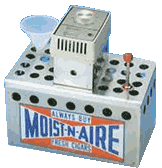 Always utilize distilled water. It will prevent clogging and is far less likely to cause molding in your humidor. I am always amazed by people who try to say their tap water is "this and that" filtered ­ don't be so cheap. You are storing cigars worth typically hundreds of dollars and distilled water costs $0.99 a gallon at the grocery store. Always utilize distilled water. It will prevent clogging and is far less likely to cause molding in your humidor. I am always amazed by people who try to say their tap water is "this and that" filtered ­ don't be so cheap. You are storing cigars worth typically hundreds of dollars and distilled water costs $0.99 a gallon at the grocery store.
All passive humidifiers will require a couple of days to settle in after being initially charged. Do not expect your humidor to be at 70% RH in just a few hours.
And most importantly, all humidifiers are going to regulate within a range of the desired RH ­ do not wig out over being a few percentage points off.
Hygrometers:
 Hygrometers are utilized to measure relative humidity and are commonly used by cigar smokers within their humidors to verify the proper humidity level is being maintained. Hygrometers are utilized to measure relative humidity and are commonly used by cigar smokers within their humidors to verify the proper humidity level is being maintained.
Both mechanical and electronic ones are available. Typically the mechanical ones are more attractive, while the electronic ones tend to be more accurate. But this is not always the case.
 Sadly, many hygrometers, both mechanical and electronic, are grossly inaccurate and require either adjustment or simply replacement. One of the easiest methods of verifying the accuracy of your hygrometer is to perform a Salt Calibration Test. Sadly, many hygrometers, both mechanical and electronic, are grossly inaccurate and require either adjustment or simply replacement. One of the easiest methods of verifying the accuracy of your hygrometer is to perform a Salt Calibration Test.
Without boring you with the chemistry of why, let me simply state that this test will always result in an achieving an exact relative humidity level of 75%.
The Salt Calibration Test procedures are:
| Materials required: |
Tablespoon of Plain Table Salt (NaCl) Two Ziplock-style baggies Bottle Cap or other suitable small container Swizzle Stick or other such item to stir with Distilled Water Your Hygrometer |
Place the tablespoon of salt on the bottle cap. The wide mouth ones that are used on individual serving juice or tea bottles are ideal.
Slowly add distilled water to the salt while blending with the swizzle stick. You want to add just enough water to moisten the salt so that it begins to meld into a thick paste. Do not add enough water to dissolve the salt!
Place the bottle cap with salt gently into the first ziplock bag and then add you hygrometer. Make certain the sensor is exposed and free of being block by the bag.
Seal the bag while capturing some air inside of it. Then place into the second bag and seal again. The double bags are needed to ensure that you really have a good seal as the test will not work if there are any leaks.
Then place the bag in a place that is free of direct sunlight and is of a stable temperature.
Leave undisturbed for a minimum of 8 hours.
Check the reading on the hygrometer through the transparent baggies and it should read on or near 75% RH.
Remember most small inexpensive hygrometers are only accurate to within 3% so do not be surprised if it reads 72% or 78% RH. It is exactly 75% RH within the confines of the bag due to the salt paste reacting with the air, and what your hygrometer reads differently is the amount of error.
What to do about off-reading depends on the circumstances. If your hygrometer has an adjustment potentiometer then by all means try to tweak it to exactly 75%. You should repeat the Salt Calibration Test again after making any adjustments. If your hygrometer doesn't have the ability to be adjusted and the reading is close then don't worry about it ­ just remember that your hygrometer is X% off either high or low.
If the reading is grossly in error and you are unable to adjust it, then I suggest you replace it.
And finally, let me say that hygrometers are not really necessary. You will find over time that you will gain the experience to be able to judge the relative humidity within your humidor by simply touching and smoking your cigars.
Alternative Cigar Storage Methods:
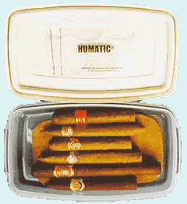 A humidor is NOT essential to cigar storage. In fact there are many inexpensive and effective means for maintaining and aging your cigars. Two of the most popular ones are "Tupperdors" and "Igloodors." A humidor is NOT essential to cigar storage. In fact there are many inexpensive and effective means for maintaining and aging your cigars. Two of the most popular ones are "Tupperdors" and "Igloodors."
A Tupperdor is nothing more than a plastic resealable food container. You can use Tupperware or any other similar product. These are inexpensive and very effective. Simply add a humidifier and you are all set. Many people place those cedar separator sheets that come from boxes of cigars on the bottom of their tupperdors to introduce the element of Spanish cedar. Remember to store your tupperdors in a dark cool place.
An Igloodor is simply a large ice cooler like those made by the Igloo or Coleman companies. They come in a wide variety of sizes with the most common being a 48 qt. model, but I know many people that utilize the giant 128 qt. models. This is an ideal way to store full boxes of cigar very inexpensively. Some people line the interior by attaching Spanish cedar with a non-toxic scentfree adhesive and others even create dividers. You can make a large humidifier, but one of the easiest solutions it to just place a trimmed brick of oasis foam in the small plastic tray that many of them come with. Igloodors are also commonly referred to as "Coolerdors."
There are only two minor drawbacks to using these for long term cigar storage:
1) They are more susceptible to becoming over humidified since their plastic walls do not help to buffer the relative humidity so it is extra important to not overcharge your humidifier. Because of the risk of higher moisture levels you need to be on the alert for the possibility of mold forming.
2) They can not breathe as a traditional humidor will. Therefore, they will trap the ammonia and off gases generated by your cigars aging within them. To alleviate this problem you should open them at least once a month to allow for an exchange of fresh air.
I have used both of these alternatives for many years to no detriment. However, most aficionados will eventually purchase a humidor as there is a sense of great satisfaction when selecting a fine cigar to smoke from a well-crafted humidor rather than a plastic container. It only seems fitting that a premium cigar should be kept in a beautiful humidor.
Cigar Aging:
I wholeheartedly subscribe to the theory that aging has a critical impact on a cigar's body and flavor. Initial aging after their rolling is essential to allow the cigar to dry and stabilize. Not only will this greatly improve the flavor, but also greatly improve the burn and draw. Stabilization takes only 6 to 8 weeks, however allowing your cigars to age even longer will let the flavors of the blend meld and mellow into a more harmonious smoke. A cigar's complexities and nuances will be greatly enhanced with long-term aging in a proper environment.
On the other hand, I am also a firm believer that cigars do not perpetually age for the better. Every cigar eventually hits its peak, and from there on it is downhill. So it is just as important to not overage your cigars, as it is to age them in the first place.
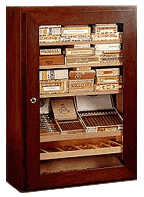 The younger the cigar the more drastic the impact time has upon it; 3 months can mean a world of difference to a freshly rolled cigar, whereas 3 months are negligible when dealing with 15 year old sticks. The younger the cigar the more drastic the impact time has upon it; 3 months can mean a world of difference to a freshly rolled cigar, whereas 3 months are negligible when dealing with 15 year old sticks.
Over time you cigars will slightly shrink and you will be able to move their rings up and down their length uninhibited by friction. This is a classic tell tale sign of a well-aged cigar and one that will most likely be an optimum smoke. Not only will it burn and draw better, it will taste smoother and share its nuance with your palate.
Another tell-tale sign off aged cigars is plume, also called bloom. This is a light whitish gray powder that is left from the cigar's essential oils drying on its surface, and is considered a very good sign that the proper aging is taking place. Not all cigars develop plume, but those that are heavy in oils almost always do over time. Cigars exhibiting plume are typically exceptional in flavor.
Well-aged cigars are a cherished commodity amongst most cigar connoisseurs and a luxury that sadly most smokers never realize. | 

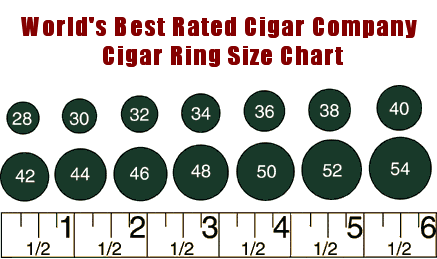
 And they will continue to do so until their own moisture content matches that of the ambient climate around them.
And they will continue to do so until their own moisture content matches that of the ambient climate around them. 
 When selecting a humidor it is best to select one with 5/8" or greater wall thickness. This thickness provides a good buffer between the outside ambient climate and your prized cigars.
When selecting a humidor it is best to select one with 5/8" or greater wall thickness. This thickness provides a good buffer between the outside ambient climate and your prized cigars.  Lift out trays and movable dividers are a big plus when selecting a humidor, particularly if made of Spanish cedar.
Lift out trays and movable dividers are a big plus when selecting a humidor, particularly if made of Spanish cedar. 

 Passive humidifiers do not rely on any power whatsoever, are of simple design, and utilize basic vapor conduction to regulate relative humidity. These devices are typically inexpensive and serve almost everyone's humidifier needs. Although not as sophisticated as active humidifiers, passive ones very capable of providing a stable environment for your cigars. Not only are they utilized in desktop humidors, but also in large cabinet furniture-size ones as well.
Passive humidifiers do not rely on any power whatsoever, are of simple design, and utilize basic vapor conduction to regulate relative humidity. These devices are typically inexpensive and serve almost everyone's humidifier needs. Although not as sophisticated as active humidifiers, passive ones very capable of providing a stable environment for your cigars. Not only are they utilized in desktop humidors, but also in large cabinet furniture-size ones as well. 
 Always utilize distilled water. It will prevent clogging and is far less likely to cause molding in your humidor. I am always amazed by people who try to say their tap water is "this and that" filtered ­ don't be so cheap. You are storing cigars worth typically hundreds of dollars and distilled water costs $0.99 a gallon at the grocery store.
Always utilize distilled water. It will prevent clogging and is far less likely to cause molding in your humidor. I am always amazed by people who try to say their tap water is "this and that" filtered ­ don't be so cheap. You are storing cigars worth typically hundreds of dollars and distilled water costs $0.99 a gallon at the grocery store. 
 Sadly, many hygrometers, both mechanical and electronic, are grossly inaccurate and require either adjustment or simply replacement. One of the easiest methods of verifying the accuracy of your hygrometer is to perform a Salt Calibration Test.
Sadly, many hygrometers, both mechanical and electronic, are grossly inaccurate and require either adjustment or simply replacement. One of the easiest methods of verifying the accuracy of your hygrometer is to perform a Salt Calibration Test. 
 The younger the cigar the more drastic the impact time has upon it; 3 months can mean a world of difference to a freshly rolled cigar, whereas 3 months are negligible when dealing with 15 year old sticks.
The younger the cigar the more drastic the impact time has upon it; 3 months can mean a world of difference to a freshly rolled cigar, whereas 3 months are negligible when dealing with 15 year old sticks.